It had been a long winter, and I had finally got out for my first full long weekend prospecting trip of the year. Normally I would have been out much sooner, but we had a real late spring in the Sierra Nevada that year with lots of late rain and snow continuing through all of March and much of April. Local weather forecasters said it was the largest snow pack ever recorded in the Sierra that late in the year.
The previous fall I had located a new spot where I had done well with my metal detector – I picked up over three quarters of an ounce of gold in just two days detecting time. That’s certainly a spot worthy of further investigation. Family issues had prevented me from getting back to that location right away, and then the weather turned and the snow began to fly and I knew it would be spring before I could return.
I was excited to be back up in the Sierra Nevada high country – I had looked forward to my return for months. As I drove up to the site, I was surprised to find that the access road into the area was very badly damaged by the rain and snow run off. Some ruts were up to 4 feet deep, and I had to put my suburban into four-wheel drive and pick my way along the road carefully. Even though I had waited until mid-May, when I started to approach my destination that excitement turned to disappointment, as there in front of me were deep drifts of snow sitting upon the road and still blocking the way. I was surprised how much snow was left in the shady areas. I'll bet the snow had been over 10 feet deep up there in the middle of winter - that’s the main reason why I had not been back in spite of how well I had done the first time in. Daytime temps were in the 80s - yet still the deep snow lingered in the shade. Melting snow covered the roadway with water and many places on the road was very muddy even though it had not rained in several weeks. After driving that road several times over the weekend, my suburban looked like a giant mud ball on wheels.
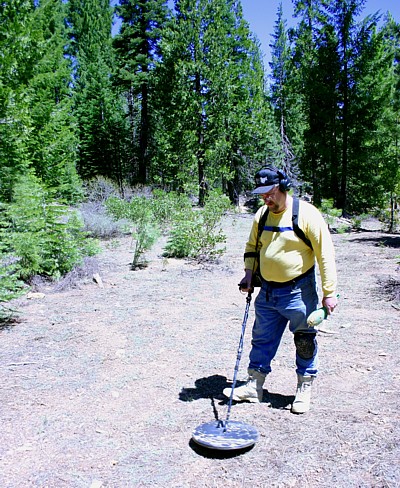
The author detecting with his GP Extreme
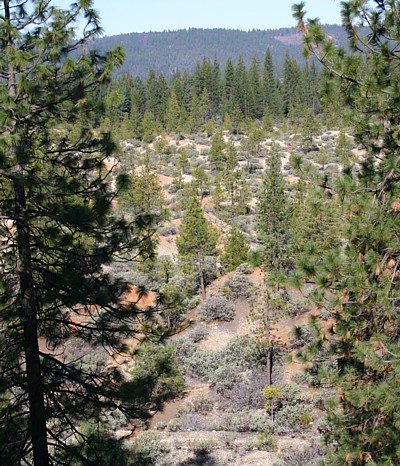
Although I couldn't get in to the precise location that I wanted to reach, there were still a few of the lowest of the workings in the same general area that were accessible before I reached the last big drift that was blocking my way. So in spite of the snow, I did get a chance to do some serious prospecting, though not exactly in the locations that I had planned.
Things started out real good at the only mine I could reach. I set up my detector and within 10 minutes I had found a real nice nugget. It had been a good strong signal and was only about 5 inches deep. It looked to be something close to a quarter ounce, and my hopes returned, because its hard to be discouraged when you’re looking at a nice nugget like that. I felt that in spite of the limitations of the snow, I was going to do real well. Unfortunately, for the rest of the weekend, every single target I found was trash. Nothing but iron wires, bullets, buttons, rusted can pieces, etc. Sometimes detecting trips are like that. I had hoped to do better but I did get my one nice nugget – after cleaning it turned out to weigh 4.2 pennyweight. Next time I am up that way, the snow will be gone and there is no doubt I'll get in much farther in. Hopefully, I will get to do some of the prospecting that I had intended for this trip.
The area where I was detecting is a location that had been ground sluiced in the old days. Ground sluicing is basically a small scale, low pressure form of Hydraulic mining. In California, hydraulic mines have been a large source of gold to prospectors armed with metal detectors. It is not uncommon that small patches of bedrock or crevices in them were overlooked by the old timers and these have yielded some nice gold. In some places, the lowest level of the gravels were strongly cemented in a manner similar to caliche. In many places, the old timers did not bother with this cemented material, and cobbles of the cemented material can be a good source of gold in old hydraulic mines. Standard high-pressure hydraulic mines are often very large and can occupy more than a thousand acres. Because of this, most of their locations are well plotted on topographic maps. As a result, many have been heavily worked over the years, yet still these mines continue to produce for the persistent prospector.
Hydraulic mining was actually first developed in California by Edward Mattison at the Coyote Diggings near Nevada City. Ditches had been dug to bring water to the rich dry diggings north of town, and the flowing water gave Mr. Mattison and idea for a new mining method. In 1852, Mr. Mattison played a stream of water under pressure against a bank of gravel thereby washing the gravels down from the bank in such a way that the gravel slurry flowed down on its own into a sluice box. The gold was recovered in the box in exactly the same manner as a standard sluice box. The technique was hugely successful, as the force of the flowing water allowed a single miner to process more gravel in a day that one could shovel into a sluice in a month. It’s use spread through the area like wildfire. Most of that early hydraulic mining was done on a small scale with low water pressure. As time went on investors began to put large sums of money into this new and successful type of mining and built long and expensive water collection systems – networks of ditches that brought water to the mines at a very high pressure. Instead of small hand held hoses, these mines had large water cannons, called giants, that shot millions of gallons of high pressure water at the banks of ancient river gravels which were often 50 to 100 feet high. This allowed the miners to process huge quantities of gravel, creating the very large hydraulic mines that are so common in the Mother Lode country and elsewhere. Eventually these mines became the victims of their own success as the vast quantities of gravels they were releasing choked rivers and streams creating flooding and agricultural damage downstream. A series of the lawsuits in the 1880s essentially shut down Hydraulic mining operations through most of California (thought they continued in some limited areas).
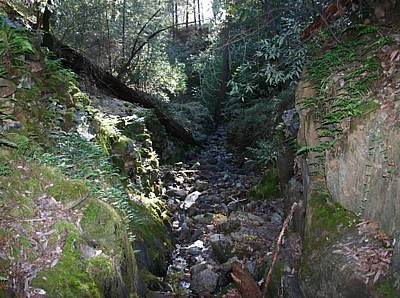
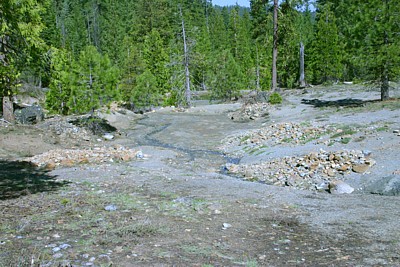
Since hydraulic mining is banned under modern environmental protections, why should today’s prospectors be interested in the small-scale hydraulic mining method known by the old timers as “ground sluicing”? The simple answer is because they have great potential for the prospector armed with a metal detector. These little known operations are much smaller in size than their gigantic brethren, and are not normally shown on topographic and other maps. Because of this, they have not been worked nearly as heavily as some of their larger cousins.
The large standard hydraulic mine workings were normally run by well-funded companies with qualified staff. Ground sluicing operations were usually run as one or two man operations and were much less efficient at recovering gold. The operation takes its name from the cuts in the ground the miners used to wash the gold bearing gravels into the sluice box. Ground sluicing also required the operators to do a fair amount of pick and shovel work to move the gravel into the sluice box – certainly nothing like doing all the work by hand shovel, but much more hand work than a larger scale mines. Deposits that were ground sluiced were smaller and often worked out within a year or two, even by small groups or even single miners, so the deposits were not a hugely productive and are far less well known, most are not documented in any mining publication. In a number of places, where they have been rediscovered, these deposits are yielding well to prospectors who have found these old sites. They have excellent potential for yielding some good, coarse gold nuggets.
Because these sites are poorly known, what are the signs that a prospector might look for in the field when searching for them? Some of the typical workings that mark these old mining sites include:
1) Ground cuts – These are basically the trenches in the ground from which ground sluicing gets its name. These narrow trenches carried the gravels to the sluice box.
2) Stacked rocks – in narrow and steep locations there was little room to move the rocks away. The old timers were forced to stack the rocks into walls along side the stream they were mining.
3) In many locations the gravels contain rocks that are too large to pass through the sluice. The miners took these rocks out of the sluice placed them into piles. These piles of coarse rocks are an easy marker for the modern prospector to see.
4) Small areas stripped of their ground cover and soils are often left behind as the mining operations processed these materials for their gold.
5) Small scale ground sluice operations could not afford to bring water from long distances. Where creek or river water was not available close at hand, ponds to collect rainwater and snow run off were often constructed, and the workings will be right below them.

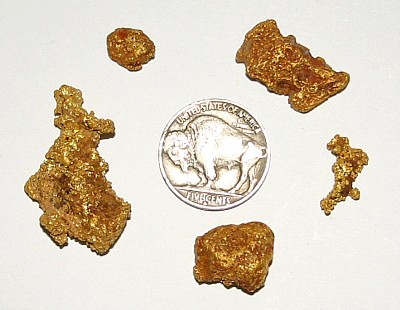
The three most common types of placer deposits which may have been worked by ground sluicing sites for these working include:
1) Gravel benches along rivers and streams, especially smaller streams
2) Tertiary river channels high on mountain tops
3) Residual placers around hard rock quartz deposits
The location I found last fall is not an old river bed, it is a residual placer that has formed near the top of a mountain and belongs in the third category noted above.
Through out the area at my new spot there are piles are tossed cobbles – They were not stacked as there was plenty of space and stacking was not necessary. I have tried them but found only a few pieces of junk - I would expect any finds in them to be gold-quartz specimen chunks - there are no fines in them and most are dropped right on the bedrock. These are cobbles that were too coarse to roll through their sluice under the low water pressure the miners had. I'll bet the sluices were just long wooden troughs with wood or rock along the bottom as riffles. The 4.2 pennyweight nugget came from an area where it appears they did not clean off the material all the way down to bedrock and the nugget was in that material that was left behind. Almost all the gold here is coarse. When I found this place last fall, I got 4 nuggets totaling over 15 dwt. The average size of all the pieces I have found up there to date is 3.9 dwt. Just as an experiment to see what amounts of fines are present, I took a couple pans full of gravel on the inside bend of a little drainage that has water in it because of the melting snow, and I did not get a single color. Plenty of black sand, but not even a speck of tiny gold (and the pan came from only about 30 feet away from where the nugget was found. It seems that the majority of the gold here is coarse. In my two trips to this area, I have seen virtually no sign that anyone else has ever detected here before, as a result I think it does have a lot of potential, but we shall see on future trips just how that works out.
The Above Article is Copyrighted by Chris Ralph, and May Not be Copied or Quoted Without Permission

